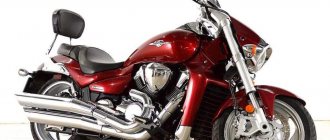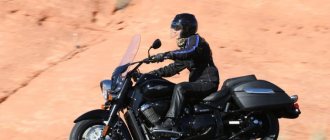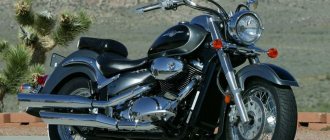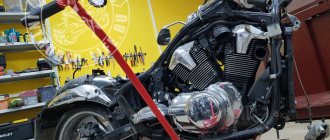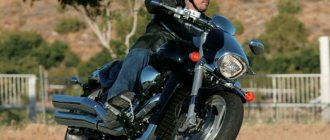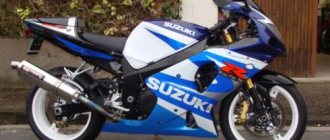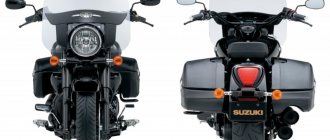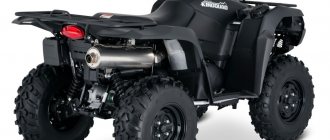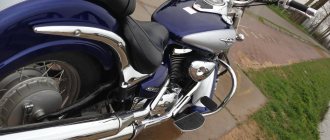The Suzuki VL1500 Intruder cruiser was first presented to the public in 1998. Several features distinguished it from the classic American Harley, but this did not stop the developers from including LC symbols in the model designation. This stands for “Legendary Classic”.
The abbreviation existed in the documentation until 2005, when the model received a slight restyling, changing its name to Suzuki C1500 Intruder (for European countries) and Suzuki Boulevard C90 (for countries of the American continent ). In the same year, the bike acquired an injector , the fuel tank became smaller by 1.5 liters (14 instead of 15.5), hydraulic compensators and a hydraulic clutch .
Release Features
Model Suzuki Boulevard C90T.
Model Suzuki Boulevard C90 BOSS
Based on the American version, they create a modification C90T . The letter stands for "tourist". The stock package adds side panniers (leather!!!), a high windshield, and also changes the saddle.
In 2012, a decision was made to curtail further production of the version for European countries. The American one receives another update a year later. In the Suzuki Boulevard C90 BOSS . (as the American began to be called), the motorcycle gets new wheels, brakes, a more powerful engine and an enlarged (up to 18 liters) fuel tank.
The tourist is also assembled on the basis of the new model, but its equipment does not change . More comfortable saddle, windshield, suitcases.
High windshield.
Comfortable separate seats.
Leather side case.
It is curious that the model includes only side cases .
There is no back one. However, some versions have a backrest for the second number (and sometimes for the driver). Because of its design, you have to decide - either it or the trunk. The motorcycle does not have a special trunk. Boulevard production continues as before, although most of the bikes are exported to North America.
A heavy cruiser, reproducing the style of American motorcycles of the 50s, it is the flagship of the Intruder model range. The motorcycle is equipped with a 1.5-liter V-engine, which is distinguished by colossal traction and amazing dynamics for motorcycles of this class. At the same time, this motorcycle is distinguished by exceptional ease of control, achieved due to the appropriate chassis geometry. A high level of comfort is provided by the rear suspension mechanism with a “hidden” shock absorber and an intermediate linkage mechanism. Suzuki wanted its new flagship motorcycle, the Intruder, to be “long, low and massive.” That's how it turned out. The 66.9-inch (1,700 mm) wheelbase is the longest of any cruiser, and the seat sits 27.6 inches (700 mm) off the ground. But Suzuki has especially succeeded in developing the “massive” concept component of its Intruder 1500 model.
At the front, the wide and deep-set fender emphasizes the large 150/80-16 tires. The massive 41mm fork tubes look even more impressive thanks to the chrome plating and chrome fork guard mounted behind the headlight. Beneath the large, teardrop-shaped gas tank, the impressive engine flexes its muscles, with large covers under elongated side panels. The seat extends a whopping 16 inches (400 mm) wide, and the 10.7-inch (270 mm) rear fender makes the 180/70-15 tire look almost petite. To call this motorcycle simply massive and corpulent would be unfair.
The large size of the Intruder 1500 LC is partly due to its design, and partly due to necessity. Many believe that Suzuki's Intruder 1400 is the best bike among the machines with large twin engines, designed in the style of choppers and competing with Harley motorcycles.
Consequently, the company sought to make its new cruiser with a larger engine wide, because this style is now very popular - wide cars have classic lines and allow large motorcyclists to feel free and comfortable in the saddle. Suzuki's desire to make the motorcycle visually wide is emphasized by parts such as the fork guard and the fender. Moreover, during the development of the bike, the designers did not limit themselves to only the initial goals, and made the car even more impressive.
Starting with the basic Intruder 1400 design, engineers increased the bore by 2.0 mm (to 96 mm) and lengthened the stroke by 3.0 mm (to 101 mm), resulting in engine displacement of 1,462 cc. The 1400 only uses oil cooling in the rear cylinder, but the 1500 cools both cylinders to compensate for the extra BTUs. A flywheel is installed on the crankshaft with traditional bearings, which has become 30% heavier. Like the 1400, the Intruder 1500 LC's crank pins are angled at 45 degrees, which, given the V-twin engine's 45-degree angle, makes for a right angle (90 degrees) between the piston paths. This design was originally designed for soft operation without the need to install a balancing shaft.
The overhead camshaft includes a conical combustion chamber with three valves; The compression ratio dropped to 8.5:1 (compression on the 1400 is 9.3:1). Unlike the 1400, which has each carburetor located behind the cylinder, both 36mm carburetors are located inside the cylinders of the V-twin engine. This simplifies the exhaust piping configuration and allows the carburetors to share the same airbox and filter. However, the chamber must be quite large (its volume is 6 liters), so it takes up the entire volume above the engine, leaving no room for fuel. The gas tank was placed under the saddle, which in turn displaced the battery, which does not require maintenance. The battery is now located in a black housing in front of the engine.
The 1500 features a stronger bottom end, a 30% heavier flywheel than the Intruder 1400, the same 45-degree cam angle, and the same 45-degree crank angle. Also, the new model inherited from the 1400 bike three valves with hydraulic adjustment per cylinder (one exhaust, two intake). With the exception of lower compression and a new tapered combustion chamber, the 1500's cylinder head and valves share most of the characteristics of the 1400. Valve sizes, angles, lift and timing remain the same. Both cylinder heads are oil cooled. The exhaust piping has been shortened to reduce heat transfer to the heads, and the intake piping is straighter and narrower than the 1400, increasing air intake speed. The cylinder coating allows the same basic housings to be used as the 1400.
Not everything is as simple as it seems with the 1500 LC. The triangular part that might be mistaken for the air filter housing actually hides some exhaust air pipes and other components. The air filter is located above the engine, under what appears to be the gas tank. Where is the fuel? Under saddle.
Because the seat is low, the height of the gas tank was limited, and the designers had to increase its width to keep the tank at a nominal 4.1 gallons (15.5 cu in). As a result, the side panels turned out to be quite bulky. Under the cover on the false gas tank there is a hole for filling fuel. Fuel is supplied to the carburetors by an electric fuel pump, the operation of which can be heard when you first turn on the ignition. There is no reserve fuel tank, but the fuel level indicator flashes when 2.7-3.0 gallons (10.2-11.3 cu in) of fuel have been used, and when 0.7 gallons (2.56 cu in) remain. , the indicator is constantly on.
The location of the gas tank helped lower the center of gravity by 1.5 inches (3.8 cm) compared to the 1400 model, and also greatly influenced the "package" of the 1500 bike. Since the tank protrudes from both sides of the motorcycle, the parts located around the tank, it was necessary to make it the appropriate width. So the saddle doesn't feel overly wide or out of sync with the bike.
On the right side, the space next to the gas tank was filled with muffler pipes, and the crankcase area was covered with a very large cover. In fact, underneath this panel is the oil dipstick cover. On the left is another large metal cover that appears to be the side of the motor housing, but in fact houses things like the fan-cooled rectifier underneath.
Another rear-facing teardrop-shaped metal cover hides the front of the driveshaft (which has also been moved outboard by 0.5 inches/13mm to make room for the rear wheel) and also covers the tool compartment.
The bike's large size shows up on the scale—the 1500 LC weighs a whopping 699 pounds with a full tank. However, the weight does not force the rider to exert much effort when holding the bike while stopping. Despite the width and height of the car, most riders will find the motorcycle manageable. But the weight manifests itself during movement. You feel uncomfortable when maneuvering in a parking lot, partly because in tight corners the steering wheel turns back and can push against your legs. However, at ultra low speeds the Intruder 1500 feels a little lighter compared to a number of other larger bikes.
Once the bike begins to move faster than walking speed, the big machine gains confidence and drives with the same stability that its imposing appearance suggests. The motorcycle is easy to maneuver in heavy city traffic, and the machine maintains the confidence of the rider when the speed reaches such a speed that they can be fined or even arrested and handcuffed. Although the bike seems to be more susceptible to crosswinds than other similar bikes, the Suzuki model does not blow off the line. The car simply begins to roll, but continues to follow the trajectory desired by the motorcyclist.
Large chrome metal covers make the engine as wide as the gas tank area and extend forward to create clean lines and distinctive, distinctive features. A protruding cover located just behind the crankcase covers the rectifier. Under the lid, which is located further, there is a compartment for tools. The black side cover on top hides the gas tank.
Turning on this big bike requires a certain amount of effort, both in corner entry and in staying on line through the turn. When braking, the LC model also begins to feel somewhat tense. Suzuki says the frame is much stiffer than the 1400, and anyone who has ridden both bikes will agree. The suspension has also become stiffer, which provides excellent handling on all bumps without exception.
The extra degree of compression damping (especially at the front) makes the ride jerky and harsh over large bumps, the bike hits the ground hard on serious uneven surfaces, and begins to shake in rough turns. The bike's ground clearance is set at an appropriate level; on the 1500, unlike other Intruder models, the folding running boards are the first to cling to the road (that's why they are equipped with special feeler levels), and not the rigid parts.
Unlike other manufacturers who created wide cruisers based on an existing engine, Suzuki did not sacrifice high power for the sake of enhancing the lower range of distribution. According to the specifications, the 1500 model produces higher peak power compared to the 1400 version, and peak torque develops at 2300 rpm. However, the 1500 weighs about 115 pounds (52 kg) more than the 1400 and also has higher gear ratios. Suzuki changed the 1400's 1.645:1 main gear ratio to 1.49:1 on the 1500.
The internal ratios of fourth (from 1.086:1 to 1.041:1) and fifth (from .96:1 to .884:1) gears have also been raised to help the engine operate more freely on highways, where it reaches speeds slightly less than 2500 rpm at 60 mph (96 km/h) in top gear. Even though the 1500 has more power than the 1400, it has to move more mass for less power-to-weight gain. As a result, the 1500 doesn't have the same strong acceleration as the 1400, which continues to be the fastest-accelerating bike among big-twin cruisers.
From a standing start, the 1400 completes the quarter mile a half-second faster, achieving nearly 3 mph (4.8 km/h) higher speeds. The 1400 also clocked about 5 mph (8 km/h) faster during our bench testing. While Kawasaki's Vulcan 1500 Classic is generally slower compared to the Suzuki 1500, the twin-carb Vulcan 1500A will also outpace the new Intruder.
The 1500 LC (according to Suzuki, "LC" stands for "Legendary Classic") produces the kind of power most riders expect from big, wide cruisers - free and measured. In this case, in the lower range of the distribution the power is plentiful. You can accelerate, practically counting the amount of exhaust gases being released into the exhaust system, and then open the throttle wide and enjoy the ride as the engine accelerates to the limiter at 6000 rpm. (the same limitation applies to the 1400 model). As the engine speed increases, the power increases without surges or dips, and the throttle response is always very clear. The flywheel's mass smooths out power almost immediately after idle.
Fully filling the under-seat gas tank is easier than most traditional tanks. However, the 1500 LC's fuel system does not include a reserve tank or fuel level. The fuel filler cap, finished in a leather-like texture, is one of the bike's several nice styling touches.
Compared to the 1400 model, fuel consumption has increased significantly. At an average speed of 35.9 mph (57 km/h), you can travel approximately 140 miles (224 km) without refueling. During our long trip, the Intruder LC consistently managed a gallon of fuel per 40 miles per gallon, compared to the Kawasaki Vulcan 1500 Classic, which managed 46 miles per gallon. 6 km). For a bike of this king size, the 4.1 gallon (15.5 liter) gas tank seems quite small. The positive feature, however, is that the design of the under-seat gas tank makes it easy and quick to raise the seat and refuel very neatly.
The engine is also smooth in other respects, and the choke should only be used on cold mornings. When you turn on the ignition, the fuel pump supplies pressure to the fuel system. When you press the starter button before it turns on, an electronically controlled release lever opens the exhaust valves and holds them open during two revolutions of the crankshaft. As soon as the starter engages, the engine is immediately ready for normal operation, without jerks or delays. Yes, when decelerating, occasionally, but very loudly, the engine backfires.
The transmission is hampered by a slight bump or jolt from the chassis, but we have a couple other gripes. Although the heel-toe shifter is conveniently positioned, the travel between cogs became longer when shifting, and we sometimes made mistakes when shifting from second to third gear. Apart from this shortcoming, shifting is positive and the five-speed transmission operates smoothly. The reverse torque limiter allows the clutch to slip if you make a mistake when downshifting, preventing the rear wheel from skidding. While the higher final ratio improves all ratios over the 1400, it more than makes up for it with the good bottom-end power that the 1500 engine has.
Our biggest complaint is the clutch. The clutch is essentially the same design found on the Intruder 1400 and has the same engagement we're used to with the 1400. As long as the power is low, the clutch engages smoothly. But as soon as the number of revolutions increases even a little, the clutch stops engaging softly. We do not mean the very top range, but we are talking about a situation where the speed is only slightly above the normal level. And we don't mean that it requires a little more effort.
The clutch acts as if you have lost control of the handle. The problem is the engagement point is too far from the engagement point, where the fingers can barely control the handle anymore and it slips out. Add in the fact that the control knobs are designed for larger hands and the hydraulic drive offers little adjustment (even though the lever itself is adjustable), and you have an idea of the problems. If you try to get ahead of the car when turning green at an intersection, your soft start suddenly turns into a violent jerk as a significant amount of the VL1500's torque is suddenly sent fully to the rear wheel. Once, in such a situation, our test driver had the steering wheel torn out of his left hand. (When your fingers can barely operate the shifter, it's difficult to grip the steering wheel.) To get a smooth start, just increase the revs a little after idling, loosen the clutch, and then accelerate.
When the clutch is engaged, the shape of the steering wheel also contributes to the problem. The handlebars are bent back about 50 degrees, so the hands are knuckled out. Consequently, the forces arising during acceleration tend to tear the steering wheel out of the hands, rather than acting on the fingers. The design of the handlebars with handles curved back suggests that the motorcyclist's body is moved back, so riders of average build do not need to unnecessarily reach forward for the handlebars. However, shorter riders may need to move closer to the handlebars to feel comfortable. But some of our test riders, even of average build, wanted the pegs to be pushed further back.
The addition of a chrome fork guard behind the headlight is a great addition, although we wish they would have covered the rear section as well. The unfinished finish on the rear fork top makes me think about buying an extra cover.
The 17-inch (43 cm) rider's seat is roomy enough to move fore and aft, but the 8-inch (20 cm) front section doesn't support the rider as well as the 16-inch (40 cm) rear seat. cm). Because the saddle is relatively flat and free of styling frills that might detract from comfort, and tightly padded with enough foam to support a heavy rider all day, this ultra-roomy saddle is our favorite among all other cruisers. The removable passenger seat is also roomier and more comfortable than most other cars.
You can spend the whole day in this saddle, and some discomfort may appear only at sunset. Wide, flat, with fairly dense foam padding, the saddle seems comfortable even after several hundred miles of travel. We give our vote to the Intruder LC for the best saddle on the cruiser market. The saddle measures 16 inches (40 cm) at its widest point.
When driving on the motorway, the shape of the handlebars and the legs pushed forward result in insufficient protection from the wind. Despite the remarkable chrome fork guard behind the 7.5-inch (19 cm) headlight, the wind feels stronger than similar bikes. Among the necessary initial changes, we would put replacing the windshield first.
While the Intruder 1500's brakes perform well, they aren't exceptional. The rear brake is easy to engage and control, which is not always easy on bikes with kickstands. Equally, the front brake has good control and decent power, despite its simple single-disc configuration with a dual-function caliper.
The brakes, or at least the rear brake, are high on our list of minor complaints about the car. They scream. The beep also squeals. Intruder models use different keys for the ignition and steering column, and we don't understand the benefits of such a system. But we liked the function of two tripmeters (trip meters) on the tripmeter/odometer LCD display.
The highly polished cast rear wheel drive housing blends seamlessly with the cast wheels; It won't be difficult to chrome them. While some people think that spoked wheels look better, alloy wheels with tubeless tires offer a number of maintenance and cost benefits, including being easier to clean.
Since the bike has no valve adjustments to adjust, no circuit to keep an eye on, and a maintenance-free battery installed, maintenance is fairly straightforward. To get to the paper air filter element, you need to remove the cover, which is a false gas tank. To do this, you need to unscrew seven bolts, remove the filter cover and the wiring going to the electronic speedometer. If you remove four more bolts you will have access to the airbox. The camo gas tank will also have to be removed to replace the spark plugs (recommended every 7,500 miles - 12,000 km), which will remove the front frame plates and chrome cylinder head covers.
Suzuki recommends changing the oil after 3,500-4,000 miles (5,600-6,400 km) and installing a new oil filter every other change. To add oil, you need to remove the engine cover on the right to get to the oil filler hole. The electric pump fuel filter is located under the seat. The 1500's superbly polished alloy wheels require no maintenance, and the tubeless tires reduce the risk of flats when punctured. In addition, such tires are easier to repair in road conditions. After 2,000 miles (3,200 km), our bike did not need any repairs or adjustments.
At the presentation of the new bike, there was one interesting moment when Suzuki talked about what would happen if the motorcycle fell off the stand onto the ground. We were shown this situation using two bikes as an example, and the damage was minimal. Both cars fell onto the top cover of the clutch hydraulic reservoir (which was barely damaged) and onto the running board. You can fix damage to the tank lid yourself and for free by simply polishing it.
The 1500 incorporates much of the pure styling of the 1400 bike; Most of the cables and wiring are hidden, and many of the visibly protruding parts of the mount are covered. The bike has a nice badge on the gas tank, beautifully shaped mufflers and wonderful engine finish. The front brake caliper is a remarkable component of the bike, with a silver finish and chrome covers, but the equally eye-catching part - the rear caliper - is left black. The brake lines are covered with braiding (springs), which gives them a metallic appearance and provides protection. However, there are some disadvantages. Many of the shortcomings are concentrated around the front of the engine - the battery is made of black metal and has a plastic housing, the rear brake master cylinder and reservoir (also black), large mounting brackets for the footrests.
At its price, the Intruder 1500 LC demonstrates that you can make a quality, large-capacity twin for a reasonable price. In addition, the motorcycle will be especially attractive to tall drivers, or simply to those who want to buy the most spacious cruiser. We suspect that for most potential buyers, styling will be a major factor. Some riders won't like the unconventional fuel tank location and a number of other styling features. Other buyers will obviously remember the old saying, “you can't be too rich or too fat,” and they will no doubt be attracted by the bike's ultra-wide and incredibly large appearance. We think we'll be seeing a lot of Intruder 1500 models on the road.
Brief conclusions
Advantages: ultra spacious, super comfortable saddle; the main emphasis is on large sizes; the most affordable among wide cruisers; high power and measured rhythm of movement on highways.
Disadvantages: sticking clutch makes not very fast starting from a standstill difficult; some parts, such as the battery, do not match the wonderful finish of other parts; Small gas tank volume for such a comfortable car.
Opinions about the motorcycle from the staff of Motorcycle Cruiser
Elvidge: Bigger is not necessarily better, and anyone who buys into this myth should be condemned to own a 1500 Intruder. I can't help but say about the appearance... Something like a cross between the Pacific Coast and a low-calorie diet. For me, the most important thing about the 1400 has always been the visual impact, the way other parts of the bike highlight the impressive engine. What in this case? In terms of equipment, the 1500 is just as much of a bumpkin on the road. The only time the bike showed impressive acceleration was when the clutch's poor performance allowed it to take off from a standstill in a fraction of a second. The idea of making the all-new Intruder a competitor to heavy duty machines like the Kawasaki Vulcan Classic was a great one. But what's the point of wearing boxing gloves that are absolutely not suitable for fighting? Complete knockout.
Brasfield: Do you know that sometimes people say “wealthy” instead of “fat”? Here... I think the developers of the 1500LC decided that fashion trends were moving towards creating pig-like cruisers. Unfortunately, my idea of a cruiser leans more towards wide bikes rather than healthy ones. As soon as I saw the LC model, I immediately decided that the acronym stood for “Lean Cuisine.”
With the exception of the clutch, Suzuki has made one of my favorite engines even better. The extra power does a great job of pulling the LC's daunting weight forward in almost all situations. Just don't expect the same acceleration as the 1400, and be careful to control the clutch carefully and keep a firm grip on the steering wheel. On the plus side, the LC doesn't have the biggest drawbacks of the 1400. The LC doesn't have the overly flexible handling of the 1400. There's no shaft effect at all, the steering is slow but stable and confident.
The added stability inspires confidence, even if the suspension isn't quite perfect. Too much compression damping makes you a little nervous when going through bumpy corners, but the LC holds its trajectory well despite the shocks. I always prefer a slightly firm suspension as opposed to a soft one. Overall, I'm pleased to note the LC's functional improvements over the 1400. But like the once-acclaimed athlete who says, "It's not fat, it's muscle," the LC needs to hit the gym to stay in shape and shed a few extra pounds. Unless, of course, this bike is just going to look impressive.
Smith: There's a lot to like about the latest Intruder. Quite a lot indeed: seven hundred pounds (317 kg), one and a half liters, 67 inches (170 cm) between the axles, a rear tire that is larger than some car tires. When I first saw the saddle, I thought that two people could ride a motorcycle, side by side. The fatness of the motorcycle is not necessarily a hindrance, but it does make me wary to some extent. I always wonder if the guys forgot about some components when developing this machine? In the case of the 1500LC model, a couple of points were indeed missed. Take the style.
The basic proportions of the bike look great, but I'm disappointed by things like the overly crude guard behind the headlight. From the front it looks too banal, and from the saddle you have to stare at its rough black surface.
Or you can look at the characteristics. Of course, the performance is quite decent, but why does the clutch have to strain its friction plates and my attention so much? Even in terms of convenience there is a drawback. The footpegs are so flat and set so far forward that I could only use them to put my heels on them. If the devil intervened in the detailed design of the bike, then Suzuki needs to perform an exorcism so that I like the largest Intruder cruiser.
Friedman: Some people believe that if the gas tank is placed under the saddle, and a surrogate tank is installed in the usual place, then this is a deception. Maybe so, but if Suzuki had done it differently, how much would the performance have deteriorated? If the tank were installed in a traditional location, a smaller air chamber would have to be installed. This would reduce performance; either the additional air intake would mean that the exhaust system would sound even quieter, or the volume of intake air would become limited.
The conflict between traditional and functional traits will definitely become more pronounced in the coming years. Old ideas about how things should be may turn out to be unacceptable, and the same can be said about systems that are made in a traditional style. Buyers will figure out what they need themselves. I'm more concerned about other styling flaws on this Suzuki model, such as the battery sticking out in front of the engine or the overly wide fender.
Personally, I like this Suzuki motorcycle. It has an ultra comfortable saddle and what really impresses me is that the bike handles so well for such a large size. But I think the real problem is the clutch drag, and this significantly reduces the number of points I would give the Suzuki. I hope someone comes up with a solution to this problem and removes the biggest flaw in a car that is otherwise quite pleasant to drive.
Specifications 1998 Suzuki Intruder 1500 LC
Designation: VL1500 Standard Colours: Black/Green, Yellow/White, Brown/Beige Optional Paint Cost: Not available Standard Warranty: 12 months/unlimited mileage Recommended Service Interval: 7,500 miles (12,000 km)
Engine and transmission
Type: air/oil cooled, 45 degree V-twin Valve system: SOHC, 2 intake valves, 1 exhaust valve per cylinder, driven by rocker arm shaft, hydraulic adjusters Volume, bore x stroke: 1462 cc cm, 96 x 101 mm Compression: 8.5:1 Carburetion: 2.36 mm Mikuni, constant section Lubrication: liquid, 5.0 quarts (4.75 liters) Fuel grade: at least 87 octane Transmission: multi-plate clutch in oil bath, 5 stages Final drive: shaft, .852:1
Chassis
Curb Weight: 669 lbs (303 kg), 55% rear Wheelbase: 66.9 in (170 cm) Overall Length: 99.4 in (252.5 cm) Seat Height: 26.7 in (67 .8cm) Column/Trail Angle: 32 degrees / 5.43" (138mm) Wheels: Alloy, 3.50" x 16" front, 5.00" x 15" rear Tire: 150/80-16 Bridgestone G703, tubeless Rear Tire: 180/70-15 Bridgestone G702, tubeless Front Brake: Dual-piston floating caliper, 11.8-inch (300 mm) disc Rear Brake: Dual-piston floating caliper, 7.1-inch (180 mm) disc Front Suspension: 41 mm tubes, 5.1 in. (130 mm) travel Rear Suspension: Single shock, 4.6 in. (117 mm) travel, preload adjustable Fuel tank capacity: 4.1 gallons (15.5 liters) ) Handlebar Width: 33.3" (846mm), Diameter: 1.0" (25mm) Foot Size Equivalent (Height): 31.2" (79cm)
Electrics and instruments
Power: 340 W Battery: 12 V, 14 Ah, maintenance-free Headlight: 55/60 W, diameter - 7.5 inches (19 cm), intensity switching (low/high beam) Brake light: one lamp Instruments : speedometer, LCD odometer/two trip meters; warning indicators for neutral, high beam, turn signal, oil pressure, fuel level.
Characteristics
Fuel consumption (mileage): 31 to 40 miles per gallon (3.79 cu in), average mileage - 35.9 miles per gallon Average mileage without refueling : 147 mph (235.2 km) RPM @ 60 mph (96 km/h) in top gear: 2490 Top speed when accelerating from 50 mph (80 km/h) in top gear on stretch 200 yards (183 m): 71.7 mph (114.7 km/h) Quarter mile (400 m) acceleration (acceleration): 14.19 seconds, 91.9 mph (147.0 km) /h).
Since the LC was first released, Suzuki has made a number of modifications, including the installation of dual front disc brakes.
Based on Motorcycle Cruiser magazine, April 1998.
Source: https://www.bikeland.ru/
Specifications
Engine type – V-shaped, 2-cylinder, 4-stroke.
The heart of the bike was a V-shaped engine with 2 cylinders. European versions were equipped with only air cooling, while the American version received liquid cooling in 2013 . The engine output:
- working volume - 1462 cm3;
- number of cylinders - 2;
- number of cycles - 4;
- number of valves - 6 (from 2013 - 8);
- power - 68 (77, in the BOSS version) hp;
- torque - 114 (133 in the BOSS version) Nm;
- cooling - air (liquid since 2013);
- fuel supply - carburetor (injector + SDTV);
- ignition - transistor (TDI);
- start - electric starter;
- tank volume - 18 l.
It is curious that the engine of the first sample was also installed on the Suzuki Boulevard M90 (Intruder M1500). There they reworked it, made it liquid-cooled, increased the number of valves to 4 (killing the hydraulic compensators at the same time) and in 2013 they finally returned it to a model whose nameplate added the word BOSS
Transmission and clutch
The cardan transmission hides some of the power, but it minimizes drive maintenance.
The bike gets a 5-speed gearbox.
According to reviews, it works easily, but you need to shift carefully; in some cases, the rear wheel tries to overtake the front.
- Multi-disc clutch , oil bath . Power transmission - hydraulics .
- The main drive is a cardan .
Brakes
Front brake.
Rear brake.
Since both axles of the bike changed the brake parameters several times, only the latest ones are given, from the BOSS version
Front:
- number of disks - 1;
- disc diameter - 330 mm;
- support - 4-piston.
Rear:
- number of disks - 1;
- disc diameter - 260 mm;
- support - 4-piston.
No options offered.
Comparison with analogues
This time, to compare our specimen, we will not select a specific opponent for it; it just so happens that the cruiser class is one of the most conservative, and we will try to find the most striking differences from its classmates.
The first thing that distinguishes our motorcycle is its controversial engine, despite the V-shape typical for the class, it is distinguished by relatively low vibrations and acceleration dynamics at the top, similar to a rower, without losing its impressive torque.
Next is the design of the motorcycle. Here we obviously had to be smart; it’s difficult to distinguish your product from the variety of similar equipment; sometimes even experienced motorcyclists cannot distinguish the models of different motorcycles, but many are able to recognize Boulevard.
The company also tried to work on the exhaust sound. In our opinion, the sound turned out to be rich, although it did not yet reach the Harley sound. The reason is largely due to the philosophy of different companies when building an engine.
Another surprising thing was the fuel consumption. It is large for a technologically complex engine, even compared to its brothers in the class with more primitive engines.
Driving performance
The huge windshield performs its function perfectly.
The maximum speed indicated in the documentation is 165 km/h . Comfortable cruiser - 100 km/h , for a tourist - 120 km/h . The difference is explained by the presence of a windshield. The glass is selected in such a way that even a tall biker faces oncoming traffic over the helmet
Acceleration from a standstill is good for a cruiser - up to 100 km/h in 5.5 seconds .
Fuel consumption
Consumption calculated by Russian users is 6.7 per 100 km (carburetor versions), or 5.9 (injector). Additional equipment for the tourist has a slight effect on the performance.
Dimensions and weight
The motorcycle is large, heavy and wide - you can’t really navigate through traffic jams.
Dry weight in 2005 increased to 302 kg .
Curb - 344 kg . For a tourist - 363 kg .
It is curious that the tourist, having stock panniers, is narrower in width than models without them:
- in length - 2,525 (2,560) mm ;
- width - 995 (990) mm ;
- in height - 1,125 (1,440) mm .
- Seat height - 720 mm .
- Wheelbase - 1,675 mm .
In parentheses are the dimensions of the tourist.
For whom is it intended?
Export version, as well as the cruiser type, assume the biker is of average height and above.
Sitting on a bike is basically as comfortable as sitting on a chair in front of the TV.
According to users, it may be uncomfortable for a short person; the ideal height is from 175 cm .
Brief history of the model
Model
: Suzuki Boulevard M109R / M1800R Intruder (Europe, North America, Australia).
Factory designation
: VZR1800K6.
2007 - no significant changes.
Model
: Suzuki Boulevard M109R / M1800R Intruder (Europe, North America, Australia).
Factory designation
: VZR1800K7.
2008 - appearance of a modification with a naked headlight.
Model
: Suzuki Boulevard M109R / M1800R Intruder;
Suzuki Boulevard M109R2 / M1800R2 Intruder (Europe, North America, Australia). Factory designation
: VZR1800K8; VZR1800NK8.
2009 is the last year of production of the naked modification.
Model
: Suzuki Boulevard M109R / M1800R Intruder;
Suzuki Boulevard M109R2 / M1800R2 Intruder (Europe, North America, Australia). Factory designation
: VZR1800K9; VZR1800NK9.
2010 - no significant changes.
Model
: Suzuki Boulevard M109R / M1800R Intruder (Europe, North America, Australia).
Factory designation
: VZR1800L0.
2011 - no significant changes.
Model
: Suzuki Boulevard M109R / M1800R Intruder (Europe, North America, Australia).
Factory designation
: VZR1800L1.
2012 - no significant changes.
Model
: Suzuki Boulevard M109R / M1800R Intruder (Europe, North America, Australia).
Factory designation
: VZR1800L2.
2013 - no significant changes.
Model
: Suzuki Boulevard M109R / M1800R Intruder (Europe, North America, Australia).
Factory designation
: VZR1800L3.
2014 - the appearance of “black” modifications - BOSS on the American market and Black Edition on the market of other countries.
Model
: Suzuki Boulevard M109R / M1800R Intruder + BOSS (Black Edition) (Europe, North America, Australia).
Factory designation
: VZR1800L4 + VZR1800BZL4.
2015 - no significant changes.
Model
: Suzuki Boulevard M109R / M1800R Intruder + BOSS (Black Edition) (Europe, North America, Australia).
Factory designation
: VZR1800L5 + VZR1800BZL5.
2016 - no significant changes.
Model
: Suzuki Boulevard M109R / M1800R Intruder + BOSS (Black Edition) (Europe, North America, Australia).
Factory designation
: VZR1800L6 + VZR1800BZL6.
2017 - no significant changes.
Model
: Suzuki Boulevard M109R / M1800R Intruder + BOSS (Black Edition) (Europe, North America, Australia).
Factory designation
: VZR1800L7 + VZR1800BZL7.
2018 - no significant changes.
Model
: Suzuki Boulevard M109R / M1800R Intruder + BOSS (Black Edition) (Europe, North America, Australia).
Factory designation
: VZR1800L8 + VZR1800BZL8.
2019 - Model available in Australia and North America only.
Model
: Suzuki Boulevard M109R / M1800R Intruder + BOSS (Black Edition) (Europe, North America, Australia).
Factory designation
: VZR1800L9 + VZR1800BZL9.
2020 - no significant changes.
Model
: Suzuki Boulevard M109R BOSS (Black Edition) (North America, Australia).
Factory designation
: VZR1800BZM0.
Modifications
It was mentioned above that the motorcycle was assembled in 2 trim levels, but there were 5 official modifications:
- Suzuki VL1500 Intruder LC — production begins with this version. It exists on the assembly line until 2004, after which it gives way to new developments. Opposed type brake calipers (2 pistons), triangular cover on air vent.
The first model of the 1998 Suzuki VL1500 Intruder LC cruiser with a carburetor engine.
- Suzuki Intruder C1500 , also known as Suzuki Boulevard C90 - from 2005 to 2012 . Continuation of the previous one. The carburetor was replaced with an injector, hydraulic valve compensators were added to the engine, and the clutch drive became hydraulic. The air vent has an oval cover.
- Suzuki Boulevard C90T is a touring assembly of the American version. Everything is the same + side cases and a high windshield. The saddle was replaced with a more comfortable one. Started in 2005 , completed in 2012 .
- Suzuki Boulevard C90 BOSS The new reincarnation of the American version was launched in 2013 . One disc remains on the front axle, the wheels are changed, and a more powerful engine is installed (the hydraulic compensators were sacrificed). Still in production today.
- Suzuki Boulevard C90T BOSS made by analogy with the previous one - everything is the same + travel kit. It can also be seen in European markets.
In its modern design, the C90T BOSS model is equipped with spacious plastic panniers.
and competitors
Competitors also presented their solutions:
- Honda VTX 1300;
- Kawasaki Vulcan VN1500;
- Yamaha XV 1600.
Unlike Suzuki, all models have already been discontinued.
Owner reviews
This year, a Suzuki Boulevard 1800 (M109) from the USA, with a mileage of 5000 km. I've ridden quite a bit this season, 1500 km, the clutch is still working, the rear wheel is actually due for a pair replacement (that's my driving style). A few points that will help with the choice: 1) I also read reviews about the Suzuki Bolevard m109r, they wrote there many times that the clutch wears out quickly and needs to be replaced, I’ll just buy it as a spare, it’s not that difficult to replace if you have spare discs. 2) As for the box, if you compare it with a liter dredge, for example, everything works great, switches clearly and without problems. 3) Regarding traction, in my subjective opinion (I haven’t carried out tests and measurements or races), the Boulevard 1800 from 0 to 60 km is faster than sports, the traction is simply crazy. You have to hold it a little, otherwise the roller will simply turn. 4) In traffic jams, no matter what, I crawl between the rows like a sportsman, besides, I disperse everyone with the Kobrovsky forward flows and warn about my approach. All that's left is to pump up the xenon, and it will be completely buzzy. In traffic jams, I drive between the rows just like sports, with my forward flow from the Cobra everyone sees and hears me, I’ll add xenon, it will be absolutely wonderful. 5) If we compare the controls, then the Suzuki Boulevard 109 steers a little harder than, for example, the same liter drag, but if we take into account its weight, then at speed you will not feel any difference. Overall, the motz is awesome! Also for those who are looking for reviews about the suzuki boulevard m109r, I will add something about what I installed additionally, this is often searched for: On the steering wheel I installed boxes for switching turns (chrome), reinforcements for the front brake and clutch (not chrome, polished) , mirrors that look like flames (only very small), Kuryakin handles in the shape of flames, I wrote about the forward flow Cobra above, I haven’t installed the bi-xenon yet, and I also want a rear headlight with diodes (this first requires the rear shelf to match the number and the turn signals, and Instead, put a strip like this under the wing). Looks great. When you turn on the turn, the taillight blinks on its own from one side to the other. And the number is illuminated by 4 LEDs from under the wing above the gearbox (on the side). In short, I think that the Suzuki Boulevard 1800 is a great bird, you won’t regret it. Ian
It took me a long time to get to this device. I collected information on the Internet bit by bit, on maintenance, breakdowns, read owner reviews about the suzuki boulevard m109r, who installed what on tuning, who improved it in what way. In general, I bought it when I was already prepared, I even bought something. To begin with, my gaze immediately fell on the rear roller. The skating rink must be wide, of course. The 250/40 wheel fits in there easily. There was no glass either, I ordered it and now it doesn’t blow me away. There were metal handles, of course they are tin, they slide without gloves, so I changed them. I also installed Arc, and most importantly, I ordered a backlight of 7 colors, I watched the videos, it looks like a bomb, but I haven’t installed it yet. This opus is about nothing, it just listed what I have staged or am about to stage, but suddenly someone will be interested. Review of suzuki boulevard m109r, left by Kirill from St. PetersburgDemid
Peculiarities
Round headlight.
Fuel tank.
Front fender.
Dashboard.
Exhaust pipes.
Rear lighting.
One of the main features of the bike was the cardan.
Hydraulic compensators were a good bonus that simplified maintenance for the user , but they were abandoned when replacing the engine in the latest versions.
According to some comments, the gearbox requires getting used to , otherwise you will have to constantly watch how the rear wheel overtakes the front, resulting in skidding during any gear change.
A separate package can hardly be called a feature, but users noted several advantages of this particular option.
Flaws
The owners list only a few disadvantages:
- the fuel tank is small (it is worth noting that the injector has a reserve of about 300 km);
- According to some users, the checkpoint is not adjusted . Overtaking the front wheel with the rear wheel - constant slipping or skidding when changing gears;
- The steering wheel is not designed for shooting between rows.
Although many people change the latter, the status of a cruiser requires understanding.
and dignity
The advantages of the bike are especially felt on the highway, where you can calmly maintain cruising speed and not even hear the noise of the engine.
More advantages:
- cardan;
- good traction throughout the entire range;
- maneuverability;
- low center of gravity, track stability;
- comfortable fit.
For tourists, they also add a high windshield that cuts off the air flow on top of the helmet.
Disadvantages of the model
As with everything, there are some disadvantages, so you also need to familiarize yourself with them.
- the motorcycle is too heavy;
- fuel is consumed uneconomically;
- if a motorcycle hits, plastic parts may be damaged;
- not entirely reliable grip;
- The front fork lacks power.
Despite its shortcomings, the motorcycle is very popular and deserves the best reviews. It is worth noting that in the markets of many countries the first place belongs to this model. He was able to win the hearts of motorcyclists with his endurance and fast riding.
After all, the most important thing for motorcyclists is speed and safety, which the manufacturers of the Suzuki M109R took care of
In addition, the model meets many requirements and is generally perfect for people who have gained extensive experience in driving such a vehicle. Of course, motorcyclists who do not have enough practice will also be able to acquire the necessary skills and feel the rhythm of fast riding of this wonderful bike, but this will take a certain amount of time.
